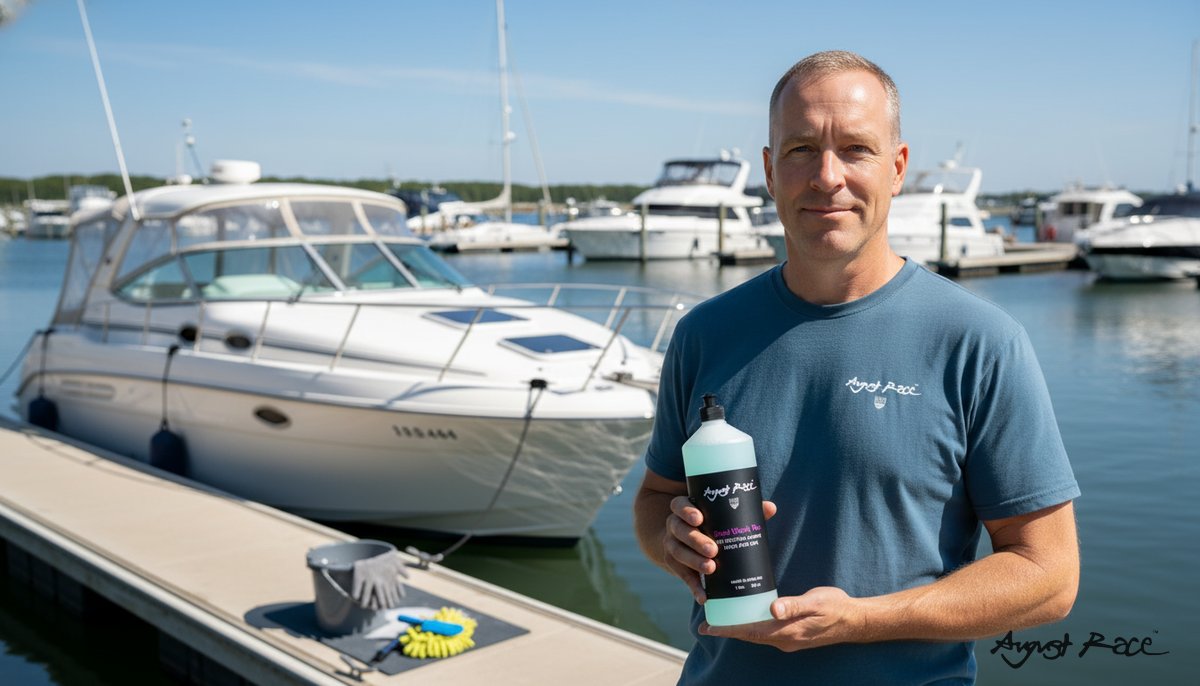Boat Wash Best Practices for Marinas: Using August Race Boat Wash Pro
As marina managers, we live by the clock. On a summer Saturday our berths fill before 9 a.m., radios chatter, and our teams move from finger pontoons to fuel dock with one eye on safety and one on presentation. A disciplined boat wash routine is what keeps us on schedule. Clean hulls, non-slip decks, and spotless fittings don’t just look good -- they support core marine cleaning goals like safe walkways, faster berth turnover, and fewer operational surprises during inspections.
Across dozens of visiting yachts and tenders, standards can slip if we don’t standardize process and product. We’ve found that pairing a tight routine with a dependable boat wash cuts labor time, reduces rework, and protects our reputation with owners and harbor authorities. The right chemistry, used the right way, makes all the difference. When you’re choosing the best boat wash for saltwater operations, prioritize speed, surface compatibility, and predictable results across different crews and shifts.
Common cleaning headaches at marinas: algae buildup, salt crust, and staining
Our monthly inspection logs repeat the same three entries:
- Green algae at the waterline and transom steps
- White salt crystallization on rails, glass, and canvas
- Stubborn staining on gelcoat and non-skid
Each issue eats time. Algae removal at the waterline can turn into repeated scrubbing if crews use the wrong chemistry or too much abrasion. Salt crust needs more than a quick rinse; it can leave mineral spotting that shows up in sunlight -- right when guests arrive. Gelcoat staining, especially around scuppers and metal fittings, often resists general detergents and sends teams back for a second pass.
We also operate under pressure. Some slips must be event-ready (youth regattas, owner open days), and our procedures need to align with local standards. Crew feedback matters too: harsh cleaners can be corrosive, slow to work, or unpleasant to handle, driving up labor costs and safety risks. The goal is a saltwater boat cleaner and workflow that hit all three marks -- effective, fast, and safe.
How August Race Boat Wash Pro tackles salt, algae, and stains at scale
To address these problems at scale, we standardized on August Race Boat Wash Pro. From a manager’s perspective, the standout features are simple: a concentrated formula, quick dwell, and smooth compatibility with our pump sprayers and pressure-wash setups. Teams can meter it consistently across multiple boats, which keeps quality uniform and training straightforward.
- Algae removal without aggressive abrasion: Used as directed, the chemistry helps break the bond algae forms on gelcoat and steps, so crews spend less time scrubbing and more time rinsing. That reduces risk of micro-scratches from over-brushing and helps maintain gloss over the season.
- Performance on salt and mineral deposits: On salty weeks, rails and screens can cake up fast. We’ve seen better results when we wash with the product rather than relying on water-only rinses. It lifts salt and helps prevent rapid re-soiling compared to general detergents, which can leave residues.
- Stain response: Around scuppers and hardware, targeted hand application during the detail pass speeds up those “photo-finish” areas. It means fewer callbacks from owners who spot shadows on white gelcoat.
- Scale-friendly logistics: Concentrate-based workflows are easier to stock and store in busy facilities. We stage labeled dilution containers, assign color-coded sprayers, and keep the pallet footprint small. Clear labeling supports cross-shift consistency. Always follow the current product spec and Safety Data Sheet (SDS) for storage and handling.
- Crew safety and surface compatibility: Operations depend on confidence. Crews need a product that’s designed for marine surfaces when used as directed, compatible with gelcoat, painted topsides, stainless, and most non-skid. As with any chemistry, we test small, inconspicuous spots first and brief teams on PPE and safe handling.
With capability covered, the key is a repeatable, multi-boat process that moves vessels through our slips quickly without sacrificing standards.
Step-by-step wash protocol for multiple vessels (efficiency-first)
Below is the workflow we use to keep throughput high while maintaining consistent results. Adapt it to your pontoons, water access points, and traffic patterns.
1) Pre-wash triage (2–3 minutes per boat)
Supervisors do a fast walk-around and tag each boat with a simple code:
- A: Salt-heavy topsides and glass
- B: Waterline algae present
- C: Staining/non-skid detail needed
They note sensitive areas (vinyl graphics, open teak, oxidized paint) and prioritize boats with earliest departures. This triage tells crews which nozzles, brushes, and wash mixes to grab.
2) Staged workflow for throughput
We run three parallel passes to keep boats moving:
- Pre-soak line: Apply August Race Boat Wash Pro using pump sprayers from the bow aft, working out of the live-drip zone to avoid walking on wet non-skid. Keep surfaces wet throughout dwell.
- Pressure-rinse line: Follow behind with a fan-tip rinse. Use a low-to-moderate setting appropriate for gelcoat and non-skid, and reduce pressure around decals, canvas seams, and aging caulk. The aim is to sheet off lifted grime, not blast.
- Detail line: A third crew spot-treats waterlines, scuppers, and fittings with wash solution, using soft brushes or pads, then final-rinses and dries glass and stainless.
On busy days, we dedicate one hose run to each line, and stage spare sprayers at mid-pier so teams don’t double back.
3) Dilution, dwell, and pressure guidance
- Dilution: Standardize the manufacturer’s general-wash dilution across your sprayers and buckets. For heavy contamination or spot treatment, follow the label’s stronger mix guidance. Clearly label all containers with the product name, dilution, and date mixed.
- Dwell time: Allow the wash to dwell per the product instructions, keeping surfaces wet. Do not let it dry on hot gelcoat. Work in sections so that by the time the pre-soak crew reaches midships, the rinse crew is ready to follow.
- Pressure and tools: Use a wide fan tip for topsides and non-skid, and a soft- to medium-bristle brush for agitation where needed. Lower pressure around decals, aging paint, and teak. Always test in a small area first.
If you operate in constant salt spray, consider a mid-week light wash using the general dilution to prevent buildup. It keeps weekend turns quicker.
4) Crew assignments and equipment staging
- One supervisor per dock controls the queue and triage tags.
- Two techs run the pre-soak; one tech runs the pressure rinse; one tech handles detail and drying.
- Stage hoses, reels, and sprayers at the head and midpoint of the pier to reduce walking.
- Keep spare nozzles, brushes, and PPE in a rolling cart. Swap out at set intervals to maintain brush softness and prevent gelcoat marring.
- Build a quick radio protocol: “Soak off bow on C-14; rinse on C-12; detail to C-10.” It reduces idle time.
5) Wastewater management and compliance
Check your marina’s discharge requirements. Common practices include:
- Use absorbent booms or drain covers at wash areas to control runoff.
- Vacuum or capture concentrated wash water during spot treatments, then dispose per local rules.
- Keep the product SDS and any environmental documentation on file for inspectors.
- Train crews on spill response and container handling.
6) Troubleshooting
- Persistent algae at waterline: Reapply wash at the label’s stronger mix for spot treatment. Lightly agitate with a soft pad and rinse. If growth is below the static waterline or involves hard fouling, schedule a haul-out or use the appropriate antifouling-safe process.
- Staining on non-skid or around fittings: Hand-apply wash, dwell as directed, and use a soft brush in crosshatch motion. Rinse thoroughly to avoid residue.
- Salt haze on glass after drying: Increase rinse volume, switch to deionized water if available, and finish with a microfiber dry. Consider a maintenance wash mid-week to prevent mineral spotting.
Finishing touches (optional)
For boats that need a final presentation step after washing, consider:
- Smooth Opacity UV wax for high-gloss finishing on suitable gelcoat.
- GRP Sealer UV as a gelcoat UV protective sealant.
- Liquid RIB cleaner for inflatable tubes on RIBs and tenders.
Operational benefits and measured results from our marina
After standardizing on August Race Boat Wash Pro and the protocol above, our logs show improvements that matter to operations:
- Turnaround time per boat decreased, especially on salt-heavy days.
- Re-clean rates dropped, freeing crews for berth prep and fuel dock support.
- Labor hours per weekend shift stabilized, even during peak traffic.
We also saw qualitative gains: better presentation at first glance, fewer owner complaints about spotting, and smoother prep for events. On the compliance side, using a purpose-built marine cleaning product and maintaining documentation has made conversations with harbor authorities more straightforward. If the product you select is labeled as a biodegradable marine wash, that can further support your environmental commitments -- verify details on the current label and SDS.
Addressing compliance and environmental concerns in busy facilities
Marina managers are accountable for discharge rules and best practices. We keep a binder (and digital folder) with SDS, product specs, and local guidance reachable from the dock office.
Regarding eco considerations: confirm whether your chosen wash is listed as an eco-friendly boat cleaner or biodegradable on its current technical data sheet. Keep those documents on file and share them with staff. For high-strength spot treatments, use containment (booms, drain covers) and capture rinse water when required. Using a biodegradable marine wash where permitted can simplify permit discussions, but always align with local regulations first.
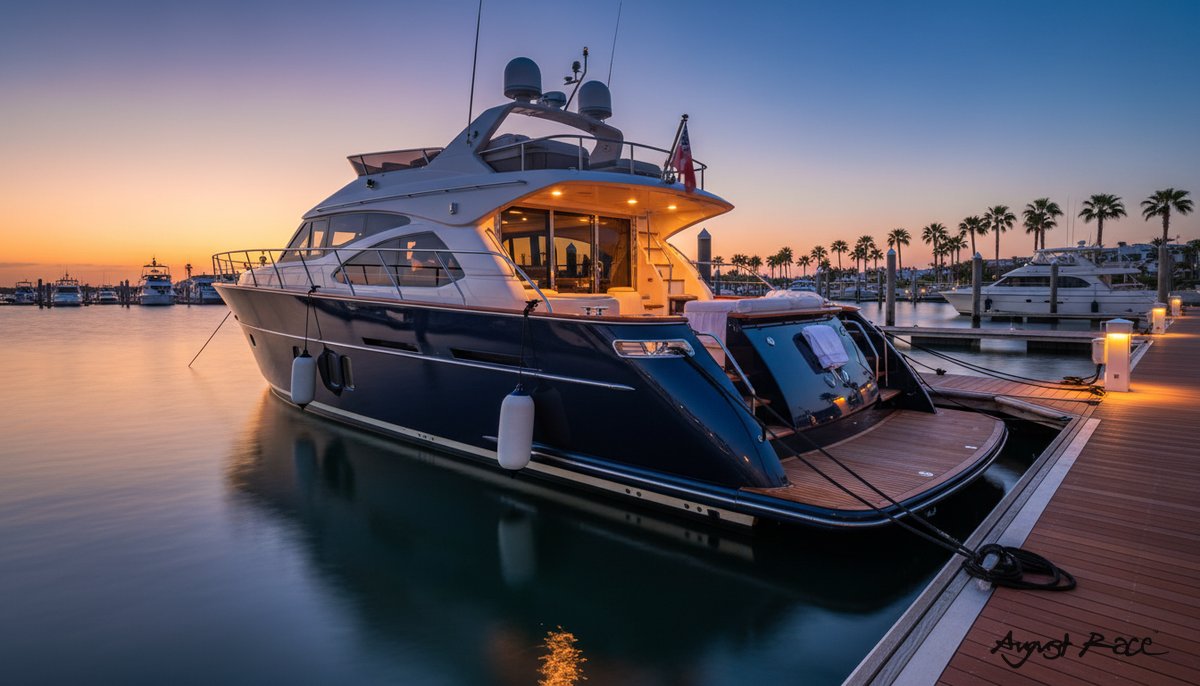
How to trial August Race Boat Wash Pro across your slips
A pilot is the fastest way to validate efficacy and throughput impacts in your conditions. Here’s a plan we recommend:
- Select a representative set of 5–10 boats (mix of sizes, finishes, and usage patterns). Record baseline times for pre-wash, wash, and re-clean occurrences for two cycles.
- Request samples or facility pricing for August Race Boat Wash Pro. Brief your staff on dilution, dwell, PPE, and sensitive-surface handling.
- Schedule washes during low-traffic windows to avoid service conflicts.
- Run the protocol for two weeks. Log turnaround time, number of touchbacks, and crew feedback each shift.
- Compare against baseline. If results are positive, roll out in phases and update your SOPs.
If you’d like a manager-to-manager walkthrough, contact August Race for a demo and current documentation. Track the same metrics you report upstream -- berth readiness times, re-clean counts, and labor allocation -- so you can quantify the impact of your boat wash choice.
Resources and quick FAQs for marina teams
- Product documentation: keep current spec sheets in your wash cart binder and digital drive; procurement via the August Race shop.
- Safety Data Sheet (SDS): train staff on first aid, handling, and storage.
- Dilution and dwell chart: follow the manufacturer’s guidance for general wash and spot treatment; post it where sprayers are filled.
Quick answers to common questions:
- Dosing for saltwater: Use the general-wash dilution for regular salt removal; for crusted areas, follow the label’s spot-treatment guidance.
- Safe surfaces: Designed for marine surfaces when used as directed; always test small, inconspicuous areas, and reduce pressure around decals and aging paint.
- Disposal: Capture and dispose of concentrated runoff per local rules; keep SDS and permits on file to support compliance.
If your team needs help with how to remove algae from boat surface without harming coatings, contact August Race support for case-specific advice. Adapt all procedures to your local regulations and marina layout.
To close, a consistent, well-briefed boat wash routine -- powered by the right product and process -- keeps our slips looking professional and our operations running on time. That’s what our owners, guests, and inspectors notice most.
FAQs
What is the best boat wash for saltwater marinas and how do I use it safely?
Look for a boat wash designed for marine use in saltwater, such as August Race Boat Wash Pro, and follow the label’s dilution and dwell instructions. Train crews on PPE, use a fan-tip rinse at sensible pressure, and test in a small area around decals and aged paint before full application.
How to remove algae from boat surface quickly without damaging gelcoat?
Apply the cleaner at the manufacturer’s recommended strength for algae, allow it to dwell while keeping the surface wet, then agitate lightly with a soft brush and rinse. Avoid harsh abrasion; if growth persists at the waterline, repeat a spot treatment or schedule a haul-out for fouling below the static line.
Is August Race Boat Wash Pro an eco-friendly or biodegradable marine wash?
Consult the current product label and Safety Data Sheet to confirm eco or biodegradable claims, as these can vary by region and formulation. Many marinas prefer biodegradable marine wash options to support permit compliance, but always verify the documentation and follow local discharge rules.
How should a marina trial a new boat cleaner across multiple slips?
Run a two-week pilot on 5–10 representative boats, capturing baseline times and re-clean rates before you start. Brief crews, standardize dilution and dwell, schedule washes in low-traffic windows, and compare results to your baseline to decide on a phased rollout.
About the Author
August Race Team
The August Race professional team brings decades of marine industry expertise and product development knowledge.
Get Expert Tips
Subscribe for marine care insights and product updates from industry professionals.
No spam. Unsubscribe anytime.
You May Also Like
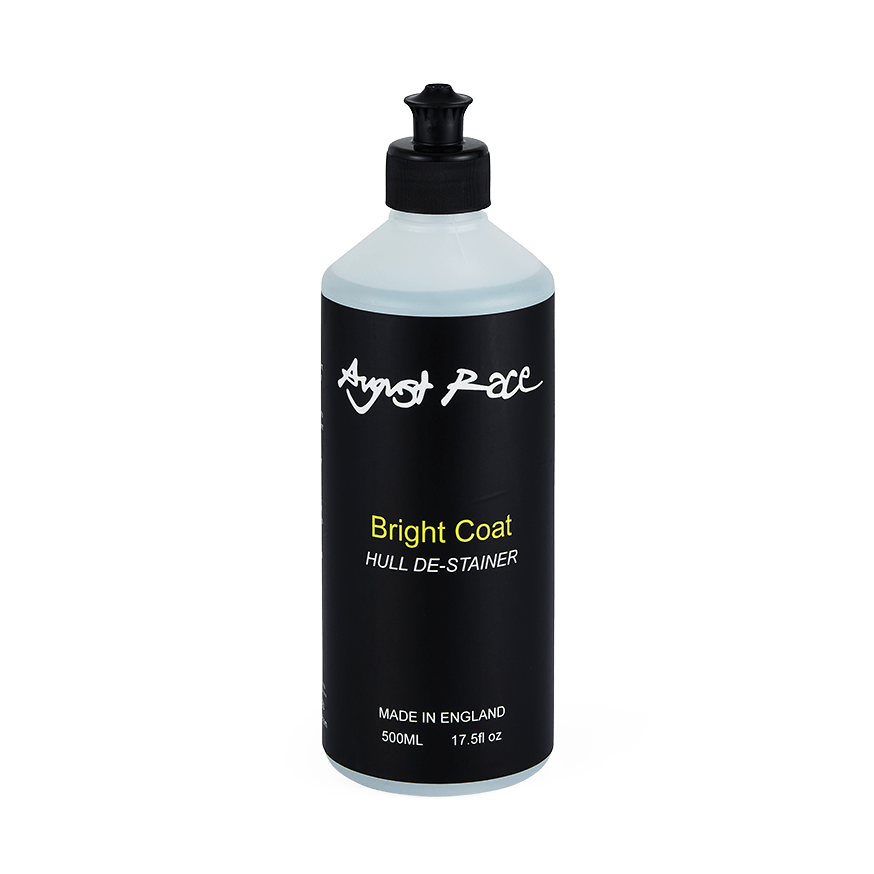
Fast Gelcoat Stain Remover for Marina Ops | Bright Coat
How our marina teams remove rust stains and yellowing fast with a non-abrasive gelcoat treatment -- scalable SOPs, batching tips, and a pilot plan.
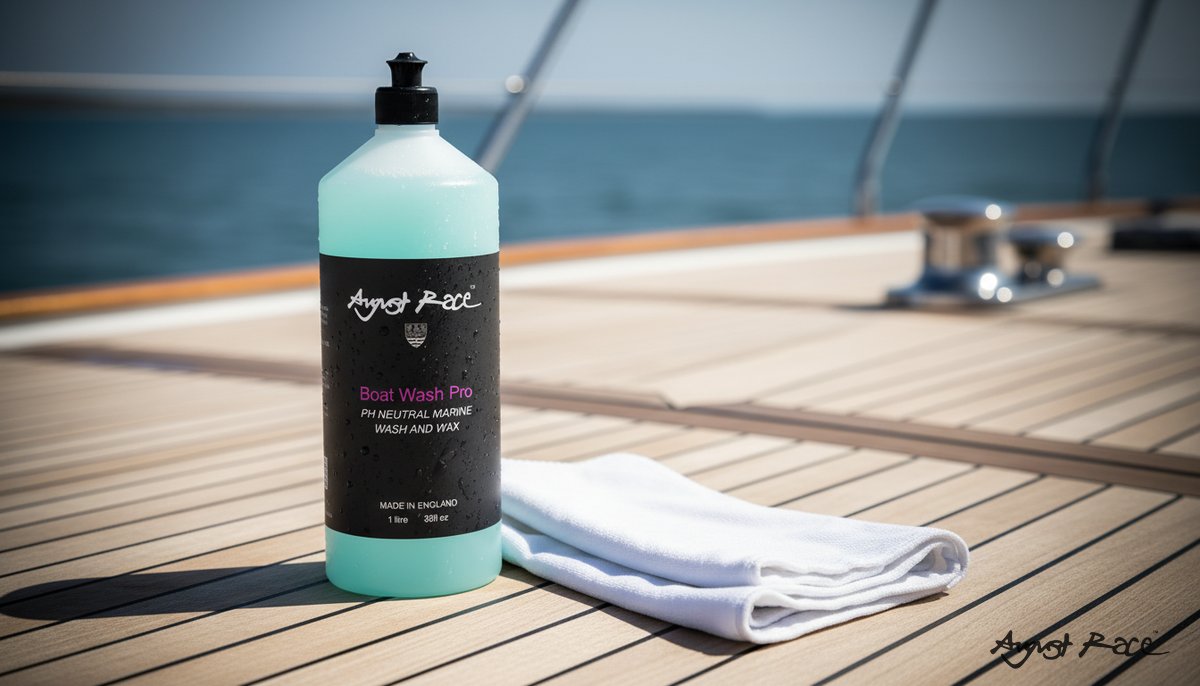
Clean Salt off Painted Boats | Biodegradable Boat Wash
Learn how to remove salt from painted boats using a marine paint cleaner and biodegradable boat wash for streak free results. Steps, tips, and FAQs.
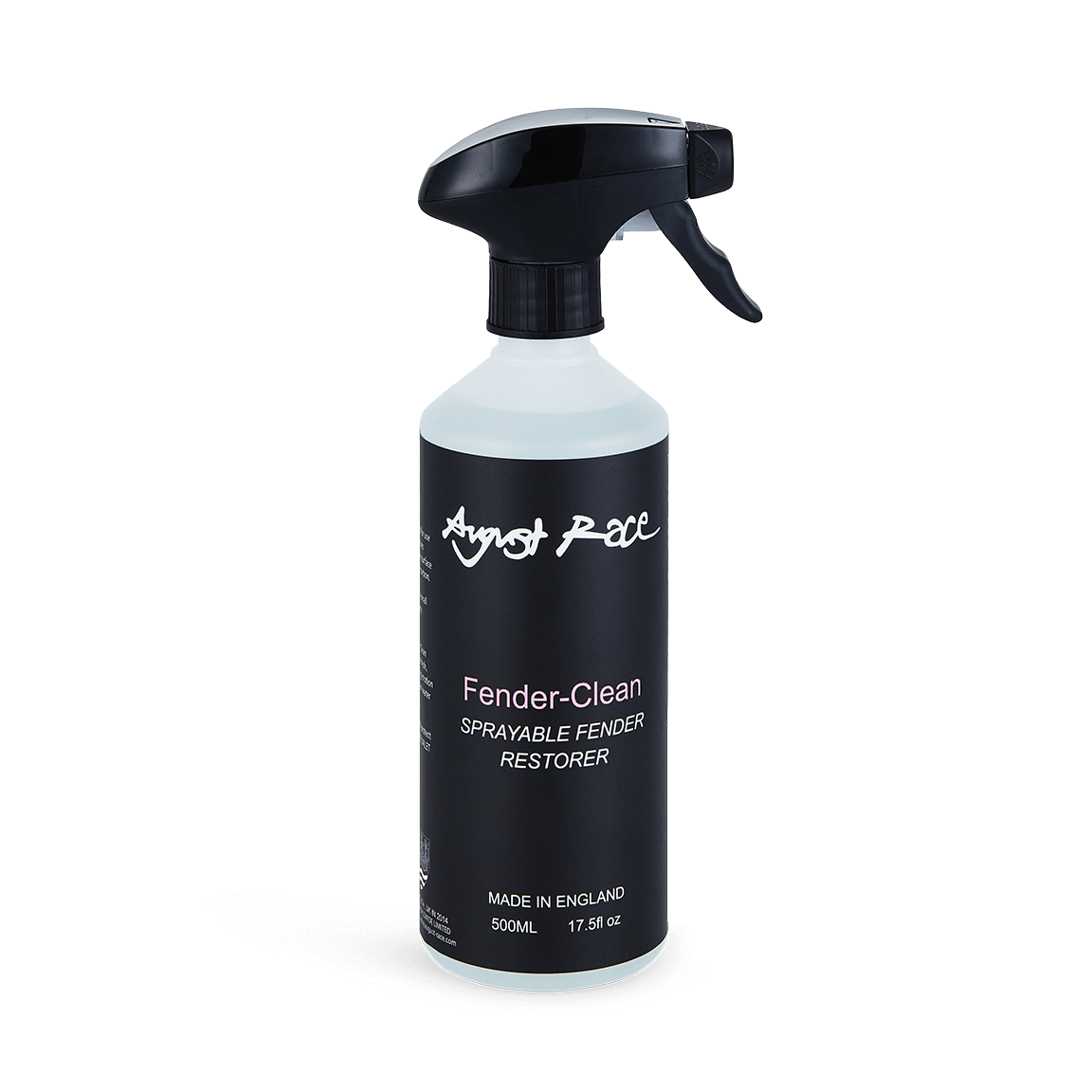
Boat Fender Cleaner: Pro Guide to August Race Fender Clean
Remove salt, oil, and biofilm from PVC and rubber fenders with a marine grime remover. Technician steps, safety, and FAQs on eco-friendly fender cleaner.
